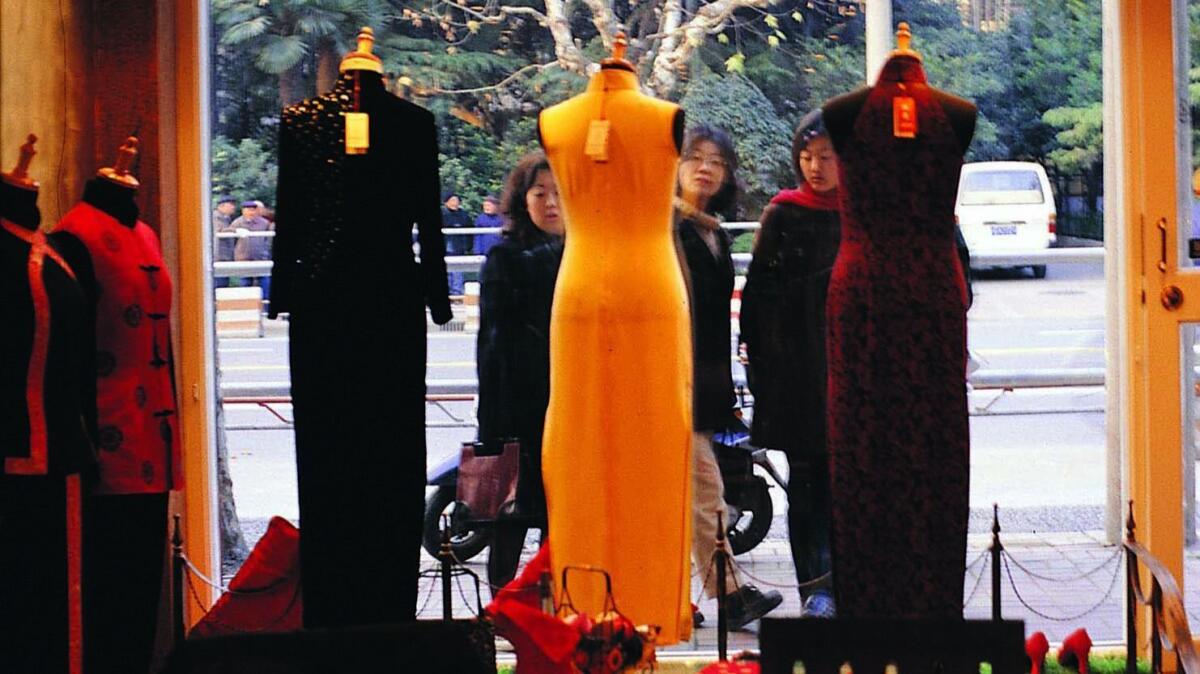Op-Ed: A white student’s Chinese prom dress defines our culture; it doesn’t maliciously appropriate yours

- Share via
One of my favorite restaurants, Kebeer, sat at the unlovely terminus of Coney Island Avenue in Brooklyn. Kebeer was a glorious wonderland of what has come to be known as cultural appropriation, the liberal borrowing of ethnic tropes by outsiders. The restaurant was outfitted like a German beer hall, though it served the cuisine of Central Asia. The food itself was cultural appropriation on a plate, an unspeakably delicious amalgam of influences from Russia, the Middle East, India and East Asia. (The peoples who lived along the Silk Road took without asking, remixed without fear.) Plus, there were burgers.
Kebeer’s eventual demise was not the result of activists massing on the corner of Coney and Brighton, demanding the place account for its freewheeling culinary approach. But charges of cultural appropriation did lead to the shuttering of Kooks Burritos in Portland, Ore., because some found it unpalatable that two white women would dabble in Mexican cuisine. Same for Hapuna Kahuna Tiki Bar & Kitchen, also in Oregon, a white man’s clumsy foray into the cuisine of Hawaii. And Hot Joy of Dallas is no more, accused of being “a clueless white-dude fantasy in which Asian identity and cuisine are reduced to a string of ironic cliches” (the food was reportedly terrible, so shed no tear).
This kind of anger is not confined to kitchen. Last week, an 18-year-old in Utah named Keziah Daum tweeted images of herself getting ready for her senior prom. The message was merely “PROM,” and the pictures were not risque, not even by pre-Trumpian standards. But, Daum, who is not ethnically Chinese, was wearing a qipao, or cheongsam, the tight-fitting dress with a high collar and a side slit, adorned with floral designs, that you are far more likely to see in a decades-old James Bond film than in any setting where modern Asian women live and work.
Appropriation is the food on which culture thrives.
The reaction was fast and furious, the kind of terrifying social-media brush fire that is the stuff of Netflix’s “Black Mirror.” “My culture is NOT your … prom dress,” tweeted someone named Jeremy Lam. “For it to simply be subject to American consumerism and cater to a white audience, is parallel to colonial ideology,” Lam added. Though he appears to have been the primary offense-taker, his messages were shared thousands of times, making an ordinary teen into a rapacious conquistador.
But, as a matter of fact, Daum properly grasped the role of “culture” in an open, humanistic society. It expresses what a society values, aspires to, recoils from. This can be true of an opera, a building, a joke. And while culture demands our participation, it refuses claims of absolute ownership. Think of the Taliban, blowing up ancient statues of the Buddha, insisting that only it alone could decide Afghanistan’s essential character. Not all such usurpations fail quite so violently, but they do all fail.
Appropriation is actually the food on which culture thrives. Pablo Picasso learned about portraiture from African masks; Picasso’s work in turn informed Jean-Michel Basquiat, who applied similar techniques to chronicle the life of an African American male in the late 20th century. As for the qipao, it was appropriated by the fashion houses of Shanghai from the Manchurian people in northern China.
When cross-cultural engagement is cruel or crass — as when, last year, a bar in Orange County mocked migrants who are here illegally in its bid to sell booze on Cinco de Mayo — reasonable citizens can resort to condemnation and shame, powerful tools that we’ve largely forgotten how to use for the civic good. Daum didn’t deserve defamation; she wasn’t being malicious or impertinent. She may not have picked her prom dress out of any deep identification with Asia or its people, but she wasn’t putting on blackface or dressing up for Halloween as a concentration camp victim.
Daum’s detractors seem to misunderstand the notion of “culture,” even as they wield the word with righteous fury. There can be no shared culture if Daum’s detractors and their ilk have their way, if culture attaches to us in absolute terms, tethered tightly to place of origin and ancestry. It’s impossible to have our culture if we’re all shouting about my culture.
The opposite of cultural appropriation is not universal reverence but, rather, segregation, a deterioration of our ability and desire to communicate with each other, a crude and insular tribalism. Outrage over Daum’s dress is a gift to nativists and xenophobes who have always been suspicious of Americans with skin darker than theirs, with homelands outside Northern Europe, holidays other than Christmas, and foods other than hot dogs.
The irony in Daum’s case is that people in China were perfectly fine with her sartorial statement. “I am very proud to have our culture recognized by people in other countries,” one person posted on a Chinese social network, according to New York Times reporting.
Daum didn’t back down from the decision to wear her red-and-gold qipao. “I’m not deleting my post because I’ve done nothing but show my love for the culture,” she wrote on Twitter, showing admirable restraint in the face of an outrage blitzkrieg. It’s just a dress,” she added, along with a well-deserved expletive for emphasis. “And it’s beautiful.”
Alexander Nazaryan is a national correspondent for Yahoo News.
Follow the Opinion section on Twitter @latimesopinion and Facebook
More to Read
A cure for the common opinion
Get thought-provoking perspectives with our weekly newsletter.
You may occasionally receive promotional content from the Los Angeles Times.









